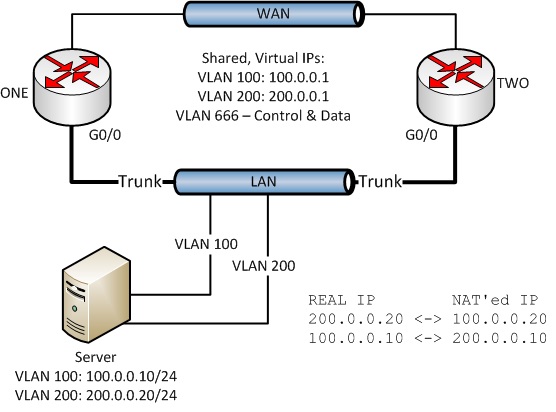- Cisco Community
- Technology and Support
- Networking
- Routing
- i have the same problem.
- Subscribe to RSS Feed
- Mark Topic as New
- Mark Topic as Read
- Float this Topic for Current User
- Bookmark
- Subscribe
- Mute
- Printer Friendly Page
NAT High Availability not using Virtual MAC Address
- Mark as New
- Bookmark
- Subscribe
- Mute
- Subscribe to RSS Feed
- Permalink
- Report Inappropriate Content
11-02-2015 07:31 AM - edited 03-05-2019 02:39 AM
We are attempting to use the NAT box-to-box high availability functionality that replaced the HSRP-based NAT failover in IOS 15.3. Unless we are doing something wrong it appears the routers respond for NAT'ed IP addresses with their physical MAC addresses instead of their shared, virtual MAC address.
Failover is accomplished using gratuitous ARPs, requiring the end device to updates its ARP table. This behavior causes problems with some of our older equipment, which ignores gratuitous ARPs.
Our setup is shown below. We have a server with interfaces in two different VLANs (VLAN 100: 100.0.0.10 & VLAN 200: 200.0.0.20). The routers are NAT'ing both the source and destination IP addresses according to the following:
REAL IP NAT'ed IP
200.0.0.20 <-> 100.0.0.20
100.0.0.10 <-> 200.0.0.10

The configuration we're using on router ONE is:
redundancy
application redundancy
group 1
name HOPE
preempt
priority 105
control GigabitEthernet0/0.666 protocol 1
data GigabitEthernet0/0.666
track 1 decrement 10
interface GigabitEthernet0/0.100
encapsulation dot1Q 100
ip address 100.0.0.2 255.255.255.0
ip nat inside
ip virtual-reassembly in
redundancy rii 100
redundancy group 1 ip 100.0.0.1 exclusive decrement 10
interface GigabitEthernet0/0.200
encapsulation dot1Q 200
ip address 200.0.0.2 255.255.255.0
ip nat outside
ip virtual-reassembly in
redundancy rii 200
redundancy group 1 ip 200.0.0.1 exclusive decrement 10
ip nat inside source static 100.0.0.10 200.0.0.10 redundancy 1 mapping-id 123
ip nat outside source static 200.0.0.20 100.0.0.20 redundancy 1 mapping-id 234 add-route
A packet capture of this behavior can be seen here. Router ONE has MAC address ending in 29:F0 and router TWO has MAC address 2B:E8.
In addition to not using a shared virtual MAC address, it appears the failover is not seamless and the two routers fight over the NAT'ed IP address. For a short time the routers appear to be split-brain. This creates further problems as the new active router only sends one gratuitous ARP for the NAT'ed addresses. The soon-to-be standby router, which still thinks it's active, responds to the new active's gratuitous ARPs with gratuitous ARPs of its own. Meaning the end devices continue to use the MAC addresses of the soon-to-be standby router and ignore the gratuitous ARPs from the new active router.
Is there a way to get the two routers in the redundancy group to share a virtual MAC address for the NAT'ed IP addresses?
If not, is there a way to get the failover to be seamless, without a period of split-brain?
- Labels:
-
Other Routing
- Mark as New
- Bookmark
- Subscribe
- Mute
- Subscribe to RSS Feed
- Permalink
- Report Inappropriate Content
12-15-2015 03:03 AM
i have the same problem.
Does anybody has a solution for this?
- Mark as New
- Bookmark
- Subscribe
- Mute
- Subscribe to RSS Feed
- Permalink
- Report Inappropriate Content
12-15-2015 07:00 AM
I've tested an EEM script that provides similar functionality by monitoring HSRP on a different subinterface and turning up/down a BVI with a MAC address and IP address that's shared by the two routers. Since only one BVI is up at a time you get HSRP-like functionality with a virtual MAC address for NAT'ing.
interface BVI10
mac-address 0000.dead.beef ! Virtual MAC addr
ip address 10.0.0.2 255.255.255.0 second
ip address 10.0.0.1 255.255.255.0 ! Virtual IP
ip nat inside
shutdown
interface GigabitEthernet0/0.10
encapsulation dot1Q 10
bridge-group 10
interface BVI20
mac-address 0000.abba.cafe ! Virtual MAC addr
ip address 192.168.0.1 255.255.255.0 ! Virtual IP addr
ip nat outside
shutdown
interface GigabitEthernet0/0.20
encapsulation dot1Q 20
bridge-group 20
! Turn up BVIs when router becomes HSRP active
event manager applet NAT-FAILOVER-ON-HSRP
event syslog pattern "HSRP-5-STATECHANGE: GigabitEthernet0/0.40 Grp 40 state .* -> Active"
action 1.0 cli command "enable"
action 1.5 cli command "config t"
action 2.0 cli command "interface bvi 10"
action 2.3 cli command "no shut"
action 3.0 cli command "interface bvi 20"
action 3.3 cli command "no shut"
action 4.0 cli command "end"
! Turn down BVIs when router becomes HSRP standby
event manager applet NAT-REMOVAL-ON-HSRP
event syslog pattern "HSRP-5-STATECHANGE: GigabitEthernet0/0.40 Grp 40 state Active -> "
action 1.0 cli command "enable"
action 1.5 cli command "config t"
action 2.0 cli command "interface bvi 10"
action 2.3 cli command "shut"
action 3.0 cli command "interface bvi 20"
action 3.3 cli command "shut"
action 4.0 cli command "end"
action 5.0 cli command "clear ip nat trans *"
! Handle case where router is first booted and might have BVI’s ‘no shut’ in config
event manager applet NAT-REMOVAL-ON-BOOT
event syslog pattern "HSRP-5-STATECHANGE: GigabitEthernet0/0.40 Grp 40 state Speak -> Standby"
action 1.0 cli command "enable"
action 1.5 cli command "config t"
action 2.0 cli command "interface bvi 10"
action 2.3 cli command "shut"
action 3.0 cli command "interface bvi 20"
action 3.3 cli command "shut"
action 4.0 cli command "end"
Discover and save your favorite ideas. Come back to expert answers, step-by-step guides, recent topics, and more.
New here? Get started with these tips. How to use Community New member guide